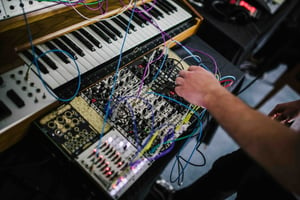While school's out for the summer our dBs Institute tutors continue getting creative. We caught up with our resident experts to learn which sound design techniques inspire them most.
Whatever field you specialise in while working in the audio world, sound design will be at the heart of the production process. Without a means of creating or generating sound there would be no project to embark on. While there are many tried and tested techniques that work extremely well, the abstract and innovative methods often lead to the most interesting results.
Our dBs Institute campuses are a hotbed for creativity and we took the opportunity to catch up with some of our degree tutors to find out about their favourite sound design techniques.
1. Create sound from nothing with 'No Input Mixing' using two mixers
This technique allows two mixers to become an instrument without any input from external sound sources. Audio is created using internal noise generated by the electronic circuit via a feedback loop between the two mixers. This is achieved by patching the send FX out from mixer one into the input of channel 1 on the second mixer. The output from mixer two is patched back into channel 1 of the first mixer, thus creating a feedback loop.
With this type of connection in place, sound as generated as you increase the send effect level from channel 1 of mixer one. Add EQ and guitar FX pedals and you have some serious sonic potential. A word of warning though, start with the volume very low on your system and don't use headphones because small tweaks can make a big impact. The No Input Mixing tutorial below should get you started.
2. Electromagnetic field recording
Attach an electromagnetic field detector, such as the Electrosluch 3+ (others makes/models are available) to an audio recorder like the Zoom H2n (again plenty of other options available) and record the sounds of electromagnet fields emitted by electronic devices. If you have lots of hardware in your studio you should have plenty of options but household devices such as remote controls, mobile phones and other items will all produce a signal. Resample the audio into your DAW and let the fun begin.
3. Randomisation using MIDI devices in Ableton Live
By using the MIDI devices available in Ableton Live you can create conditions where a set of plugins create self generated melodic and harmonic sequences for you. This method can lead to unique and interesting results that you might not have found using manual playing or programming methods.
The basic process involves creating three MIDI tracks, without an instrument assigned. Each track has a single note (any note) programmed in. The tracks are sent to another MIDI bus track. The MIDI bus track uses Ableton's 'Random' MIDI effect to create random notes. This is followed by the 'Chord' effect used to turn the random notes into chords.
Finally you add the scale device to ensure all of the random notes created are locked to a scale making the results more musical. You can then send the MIDI information from your MIDI bus to an instrument or another MIDI track and record the results. If you want help setting this up check out our masterclass from ELPHNT below for a full tutorial.
4. Circuit Bending
Circuit Bending involves hacking, customising and experimenting with the circuits of low voltage toy instruments, effects pedals and digital synthesisers. Altering the circuits found in these devices can lead to some very unique and happy accidents. This type of approach enables you to create your own bespoke instruments and sound libraries helping you to stand out from the crowd.
Ready to get your hands dirty? Music Production & Sound Engineering & MA Innovation in Sound course leader Stu Welsh's fascinating Noise Reduction blog is a great place to start.
5. Velocity as a modulation source
The humble velocity control on a synthesiser is often overlooked when embarking on a programming session. Using it as a source for multiple destinations can yield some amazing results. Setting up your modulation in this way can provide you with vastly different sounds each time a key is pressed at a new velocity level. If you want to create movement in a sequence you can program subtle changes to the velocity for each note in your sequence, sit back and enjoy the results.
Check out our BA (Hons) Sound Design degree if you're ready to get seriously stuck into the exciting world of audio manipulation.


